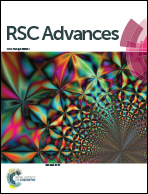Embedded cobalt oxide nano particles on carbon could potentially improve oxygen reduction activity of cobalt phthalocyanine and its application in microbial fuel cells
Abstract
The increasing cost of precious metals, especially platinum, as oxygen reduction catalysts has hindered their widespread use in microbial fuel cells (MFCs). There is an obvious importance for the development of alternative catalysts based on nonprecious metals. Here, we investigated the possibility of cobalt phthalocyanine (CoPc) as an oxygen reduction reaction (ORR) catalyst in an air-cathode MFC. Electrochemical results revealed that cobalt oxide incorporation positively shifted the ORR onset potential of CoPc. Rotating ring-disk experiments confirmed that CoPc exhibited an apparent 4e− reduction pathway in the composite system with minimal hydrogen peroxide production. When applied to MFCs, a maximum power density of 780 mW m−2 was achieved with the C-CoOx–CoPc cathode, which was about 50% higher than that with C-CoPc. The voltage output of the MFC dropped only 19% from its initial voltage after 100 days of operation, indicating that our synthesized catalysts are fairly stable over longer operation. The voltage drop partially resulted from the covering of biofilm on the catalyst layer, 89–92% of which was reinstated upon scraping off the biofilm. This work shows that C-CoOx–CoPc could be a potential alternative to Pt in MFCs for sustainable energy generation and a guide to the promising metal oxide-loaded ORR catalyst design.


 Please wait while we load your content...
Please wait while we load your content...